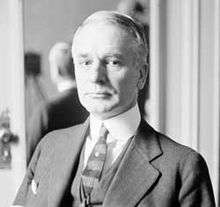Tennessee's 4th congressional district
| Tennessee's 4th congressional district | ||
|---|---|---|
.tif.png) | ||
| Current Representative | Scott DesJarlais (R–South Pittsburg) | |
| Population (2000) | 632,143 | |
| Median income | $31,645 | |
| Ethnicity | 93.3% White, 4.4% Black, 0.3% Asian, 1.6% Hispanic, 0.3% Native American, 0.1% other | |
| Cook PVI | R+18[1] | |
The 4th Congressional District of Tennessee is a congressional district in southern Tennessee. It has been represented by Republican Scott Desjarlais since January 2011.
Current Boundaries
The district lies in mostly in the southern part of Middle Tennessee, but stretches into East Tennessee. It is currently composed of the following counties: Bedford, Bledsoe, Franklin, Grundy, Lincoln, Marion, Marshall, Moore, Rhea, Rutherford, Sequatchie, and Warren. It also contains significant portions of Bradley, Maury, and Van Buren counties.
Characteristics
Most of the district is rural, but many residents live in suburbs of Chattanooga and Nashville. The area is very hilly, and has many well-known geographical features related to its location on the Cumberland Plateau. Possibly the most famous of these is Fall Creek Falls in Van Buren County.
This part of Tennessee has several well-recognized distilleries such as Duck River, George Dickel, Southern Pride, and most famously the Jack Daniel's Distillery in Lynchburg.[2]
The region encompasses many of Tennessee's higher education facilities, such as Middle Tennessee State University, Sewanee: The University of the South, Bryan College, and Lee University.
According to the 2010 census, the five largest cities are Murfreesboro (108,755), Cleveland (41,285), Smyrna (39,974), LaVergne (32,588), and Shelbyville (20,335).
History
Throughout the 20th century, the 4th district took many different forms. Though, in most cases, it encompassed most of the rural area between Nashville and Knoxville. It has often been the state's largest district in terms of area, and one of the largest east of the Mississippi River, because of low population density and the district's rural character.
For almost thirty years (1947-1977), this area of Tennessee was represented in Congress by Joe L. Evins .(Early in his political career, his district was numbered as the "5th", but that district was almost entirely in what is now the 4th.) [3] Evins' successor in Congress was future vice president Al Gore, Jr., who represented the 4th from 1977 to 1983 before being redistricted into the 6th.
Following the 1980 census, Tennessee gained a new congressional seat, and arguably, the 4th was the district which changed the most. Parts of what were previously in the 1st, 2nd, 3rd, 4th, and 6th districts were combined to form a new 4th district. The new district took pieces of traditional heavily Republican East Tennessee and traditionally Democratic Middle Tennessee. It was so large, that it stretched across four of Tennessee's eight television markets (Nashville, Knoxville, Chattanooga, and Tri-Cities). [4]
In 1982, Democrat Jim Cooper, son of former governor Prentice Cooper defeated Cissy Baker, daughter of Senate Majority Leader Howard Baker. Cooper went on to represent the district for the rest of the 80s and early 90s. [5] He then retired from Congress to run for Senate in 1994, where he lost to Fred Thompson.
Cooper was succeeded by Republican Van Hilleary, making it the first time that the region had been represented by a Republican since the 1920s, and only the second time since Reconstruction.
In 2002, Hilleary made a failed attempt to become Governor of Tennessee, and was replaced by state senator Lincoln Davis. Davis held the seat for much of the 2000s.
In 2010, Davis was challenged by South Pittsburg doctor Scott DesJarlais, who rode to victory on the Tea Party wave of 2010 despite Davis raising more money. [6] This marked the first time that an incumbent had been defeated in the district since the reformation of the district in 1980.
Following the Desjarlais victory and the 2010 census, the 4th was altered to its current configuration. The district lost all of its northern Tennessee holdings, and those near Knoxville. On the other hand, the 4th gained significant additions with Rutherford County and northern Bradley County
List of representatives
| Name | Years | Party | District Residence | Notes | |
|---|---|---|---|---|---|
| District created March 4, 1813 | |||||
| John H. Bowen | March 4, 1813 - March 4, 1815 | Democratic-Republican | |||
| Bennett H. Henderson | March 4, 1815 - March 4, 1817 | Democratic-Republican | |||
| Samuel E. Hogg | March 4, 1817 - March 4, 1819 | Democratic-Republican | |||
| Robert Allen | March 4, 1819 - March 4, 1823 | Democratic-Republican | Redistricted to the 5th district | ||
| Jacob C. Isacks | March 4, 1823 - March 4, 1825 | Jacksonian D-R | Winchester | ||
| March 4, 1825 - March 4, 1833 | Jacksonian | ||||
| James I. Standifer | March 4, 1833 - March 4, 1835 | Jacksonian | Kingston | Redistricted from the 3rd district | |
| March 4, 1835 - March 4, 1837 | Anti-Jacksonian | ||||
| March 4, 1837 - August 20, 1837 | Whig | Died | |||
| Vacant | August 20, 1837 - September 14, 1837 | ||||
| William Stone | September 14, 1837 - March 4, 1839 | Whig | Sequatchie County | ||
| Julius W. Blackwell | March 4, 1839 - March 4, 1841 | Democratic | Athens | ||
| Thomas J. Campbell | March 4, 1841 - March 4, 1843 | Whig | Rhea County | ||
| Alvan Cullom | March 4, 1843 - March 4, 1847 | Democratic | Livingston | ||
| Hugh Hill | March 4, 1847 - March 4, 1849 | Democratic | McMinnville | ||
 John H. Savage John H. Savage |
March 4, 1849 - March 4, 1853 | Democratic | Smithville | ||
| William Cullom | March 4, 1853 - March 4, 1855 | Whig | Carthage | Redistricted from the 8th district | |
 John H. Savage John H. Savage |
March 4, 1855 - March 4, 1859 | Democratic | Smithville | ||
 William B. Stokes William B. Stokes |
March 4, 1859 - March 4, 1861 | Opposition | Alexandria | ||
 Andrew J. Clements Andrew J. Clements |
March 4, 1861 - March 4, 1863 | Unionist | Lafayette | ||
| American Civil War | |||||
| Edmund Cooper | July 24, 1866 - March 4, 1867 | Unionist | Shelbyville | ||
 James Mullins James Mullins |
March 4, 1867 - March 4, 1869 | Republican | Shelbyville | ||
 Lewis Tillman Lewis Tillman |
March 4, 1869 - March 4, 1871 | Republican | Shelbyville | ||
 John M. Bright John M. Bright |
March 4, 1871 -March 4, 1875 | Democratic | Fayetteville | Redistricted to the 5th district | |
| Samuel M. Fite | March 4, 1875 - October 23, 1875 | Democratic | Carthage | Died | |
| Vacant | October 23, 1875 - December 14, 1875 | ||||
 Haywood Y. Riddle Haywood Y. Riddle |
December 14, 1875 - March 4, 1879 | Democratic | Lebanon | ||
 Benton McMillin Benton McMillin |
March 4, 1879 - January 6, 1899 | Democratic | Celina | Resigned after being elected Governor | |
| Vacant | January 6, 1899 - March 4, 1899 | ||||
| Charles E. Snodgrass | March 4, 1899 - March 4, 1903 | Democratic | Crossville | ||
| Morgan C. Fitzpatrick | March 4, 1903 - March 4, 1905 | Democratic | Hartsville | ||
| Mounce G. Butler | March 4, 1905 - March 4, 1907 | Democratic | Gainesboro | ||
 Cordell Hull Cordell Hull |
March 4, 1907 - March 4, 1921 | Democratic | Celina | ||
 Wynne F. Clouse Wynne F. Clouse |
March 4, 1921 - March 4, 1923 | Republican | Cookeville | ||
 Cordell Hull Cordell Hull |
March 4, 1923 - March 4, 1931 | Democratic | Celina | ||
| John R. Mitchell | March 4, 1931 - January 3, 1939 | Democratic | Crossville | ||
 Albert Gore, Sr. Albert Gore, Sr. |
January 3, 1939 - December 4, 1944 | Democratic | Carthage | Resigned December 4, 1944 to enter US Army | |
| Vacant | December 4, 1944 - January 3, 1945 | ||||
 Albert Gore, Sr. Albert Gore, Sr. |
January 3, 1945 - January 3, 1953 | Democratic | Carthage | ||
 Joe L. Evins Joe L. Evins |
January 3, 1953 - January 3, 1977 | Democratic | Smithville | Redistricted from the 5th district | |
 Al Gore Al Gore |
January 3, 1977 - January 3, 1983 | Democratic | Carthage | Redistricted to the 6th district | |
 Jim Cooper Jim Cooper |
January 3, 1983 - January 3, 1995 | Democratic | Shelbyville | ||
 Van Hilleary Van Hilleary |
January 3, 1995 - January 3, 2003 | Republican | Spring City | ||
 Lincoln Davis Lincoln Davis |
January 3, 2003 - January 3, 2011 | Democratic | Pall Mall | ||
 Scott DesJarlais Scott DesJarlais |
January 3, 2011 - Present | Republican | South Pittsburg | Incumbent | |
Historical district boundaries

See also
References
- ↑ "Partisan Voting Index Districts of the 113th Congress: 2004 & 2008" (PDF). The Cook Political Report. 2012. Retrieved 2013-01-10.
- ↑ http://www.tennesseewhiskeytrail.com/map-guide/
- ↑ http://cdmaps.polisci.ucla.edu/
- ↑ http://www.tvb.org/research/measurement/131627
- ↑ http://content.time.com/time/magazine/article/0,9171,925782,00.html
- ↑ http://elections.nytimes.com/2010/house/tennessee/4
- Martis, Kenneth C. (1989). The Historical Atlas of Political Parties in the United States Congress. New York: Macmillan Publishing Company.
- Martis, Kenneth C. (1982). The Historical Atlas of United States Congressional Districts. New York: Macmillan Publishing Company.
- Congressional Biographical Directory of the United States 1774–present
- Political Graveyard database of Tennessee congressmen
External links
Congress.com: Tennessee Congressional districts
- Google map of Tennessee's 4th district at GovTrack.us
- National Atlas maps of all congressional districts
- U.S. Census data searchable by congressional district
- Opensecrets.org Fundraising data from FEC reports
- 2006 results by county from CBSNews.com
Coordinates: 35°15′44″N 86°37′44″W / 35.26222°N 86.62889°W
